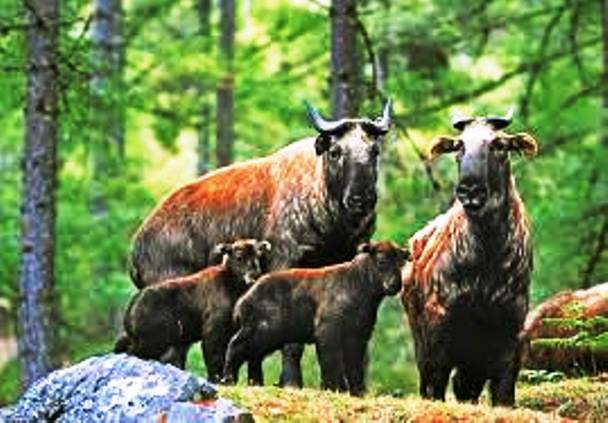The Takin – National Animal (an elusive goat-cow hybrid of the Himalayas)
~ About Bhutan~ BHUTAN – The Name
~ Bhutan and Buddhism
~ Archery - National Sport, Pass-time and Passion
~ The Raven -National Bird and the Embodiment of a Guardian Deity

Nestled away in the Himalayas is a gigantic, crescent-horned creature that nibbles its way through the alpine forest - the Takin, which we Bhutanese refer to as ‘Drong Gyemtsi.’ The mysterious beast which has remained largely out of human sight for centuries is the National Animal of Bhutan. As per the local description, it is supposed to possess the face of a goat and the body of a cow.
Those in the West however, describe it as an unusual cross between a moose, bison and a wildebeest, with some other uncommon traits thrown in as well. One distinctive feature is its odd schnoz, which has inspired a host of nicknames such as ‘bee-stung moose,’ ‘gnu-goat’ and ‘goat-antelope.’ It is because of the rather strange features that some even describe it as a creation of Dr. Seuss. These large and powerful animals have adapted to live in challenging environs, namely the mountainous areas of China, Bhutan, India and Myanmar.
Those in the West however, describe it as an unusual cross between a moose, bison and a wildebeest, with some other uncommon traits thrown in as well. One distinctive feature is its odd schnoz, which has inspired a host of nicknames such as ‘bee-stung moose,’ ‘gnu-goat’ and ‘goat-antelope.’ It is because of the rather strange features that some even describe it as a creation of Dr. Seuss. These large and powerful animals have adapted to live in challenging environs, namely the mountainous areas of China, Bhutan, India and Myanmar.
Actually it is the odd looking nose that helps it in its adaptation to cold environments. Its sizeable nose has a large sinus cavity where the air can warm up before entering the lungs. The warm air helps in keeping everything inside its body warm.
Weighing upto 770 pounds and looking like a creature straight out of a children’s book, the Takin has inspired ancient myths and legends too. As per Bhutanese accounts, the unique looking animal is associated with Lam Drukpa Kinley, a fifteenth century saint, referred to by the Westerners as the ‘Divine Madman’ due to his unorthodox ways of teaching. Legend has it that the saint created this unique looking creature after a meal of goat and cow meat during which he was supposedly fed more of the leaner parts by those who didn’t agree with his methods. Having finished his meal, he is said to have stuck the skull of the goat on the carcass of the cow and told it to go eat some more as it hadn’t fed well during its lifetime. It is maintained that the carcass miraculously came to life and ran towards the mountains, thus resulting in this never seen before animal coming to life. And that is how Bhutan’s National Animal came into being.
In the other parts of the world, its thick wooly coat that can range in color from a reddish-brown to a creamy white golden color has resulted in it being referred to as a golden-fleeced cow. Its golden coat is so striking that some believe the golden Takin inspired the tale of the Golden Fleece in ancient Greek mythology. According to the myth, Poseidon, the God of the sea and a nymph once had a golden and winged ram known as Chrysomallos. Chrysomallos was sacrificed and its pelt mounted, following which a hero named Jason was assigned the task of retrieving it in order to claim the throne to his kingdom.
Though it is known as the largest terrestrial mammal that lives in obscurity, in Bhutan, it is not so obscure…..the Takin can be seen at the Takin Zoo at Thimphu, the capital city of Bhutan. Some years ago the Fourth King decided that a zoo was not in keeping with Bhutan's environmental and religious convictions, and therefore they were set free. But despite being released, the supposedly obscure animals refused to return to the wild, preferring to scavenge around the streets of Thimphu instead. Eventually the only solution that remained was to put them back into captivity.
The Takin and its four sub-species are listed as endangered and vulnerable on the International Union for Conservation database.
Weighing upto 770 pounds and looking like a creature straight out of a children’s book, the Takin has inspired ancient myths and legends too. As per Bhutanese accounts, the unique looking animal is associated with Lam Drukpa Kinley, a fifteenth century saint, referred to by the Westerners as the ‘Divine Madman’ due to his unorthodox ways of teaching. Legend has it that the saint created this unique looking creature after a meal of goat and cow meat during which he was supposedly fed more of the leaner parts by those who didn’t agree with his methods. Having finished his meal, he is said to have stuck the skull of the goat on the carcass of the cow and told it to go eat some more as it hadn’t fed well during its lifetime. It is maintained that the carcass miraculously came to life and ran towards the mountains, thus resulting in this never seen before animal coming to life. And that is how Bhutan’s National Animal came into being.
In the other parts of the world, its thick wooly coat that can range in color from a reddish-brown to a creamy white golden color has resulted in it being referred to as a golden-fleeced cow. Its golden coat is so striking that some believe the golden Takin inspired the tale of the Golden Fleece in ancient Greek mythology. According to the myth, Poseidon, the God of the sea and a nymph once had a golden and winged ram known as Chrysomallos. Chrysomallos was sacrificed and its pelt mounted, following which a hero named Jason was assigned the task of retrieving it in order to claim the throne to his kingdom.
Though it is known as the largest terrestrial mammal that lives in obscurity, in Bhutan, it is not so obscure…..the Takin can be seen at the Takin Zoo at Thimphu, the capital city of Bhutan. Some years ago the Fourth King decided that a zoo was not in keeping with Bhutan's environmental and religious convictions, and therefore they were set free. But despite being released, the supposedly obscure animals refused to return to the wild, preferring to scavenge around the streets of Thimphu instead. Eventually the only solution that remained was to put them back into captivity.
The Takin and its four sub-species are listed as endangered and vulnerable on the International Union for Conservation database.
